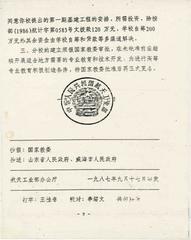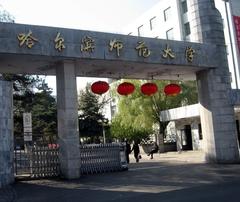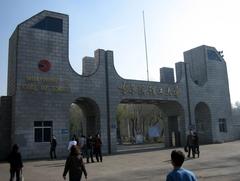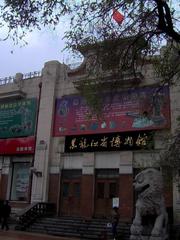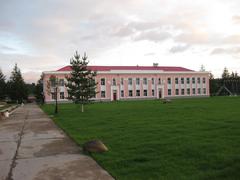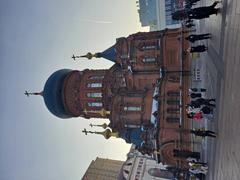Ji Le Temple Visiting Hours, Tickets, and Travel Guide in Harbin
Date: 14/06/2025
Introduction
Ji Le Temple (极乐寺), also known as the Temple of Bliss, is the largest and most significant Buddhist complex in northeastern China, located in Harbin, Heilongjiang Province. Founded between 1920 and 1924 under the guidance of Master Tanxu, a pivotal figure in the Tiantai Buddhist revival, the temple exemplifies both the cultural diversity and religious vitality of the region. The name “Ji Le”—meaning “Ultimate Bliss”—reflects the Mahayana Buddhist aspiration for enlightenment and peace, symbolized by the Western Pure Land of Amitabha Buddha.
Visitors to Ji Le Temple are welcomed into a harmonious environment that unites traditional Buddhist architecture, tranquil gardens, and living spiritual practice. The temple is not only an architectural treasure but also an active spiritual hub, hosting daily rituals, major Buddhist festivals, and educational programs that foster interfaith dialogue and cultural exchange. Conveniently situated near Harbin’s Central Street and other historic landmarks, Ji Le Temple is an essential destination for travelers seeking to explore the city’s rich cultural heritage.
This guide provides a detailed overview of Ji Le Temple’s historical background, architectural features, visitor information (including hours, tickets, and accessibility), and tips for making the most of your visit. For official details and additional resources, see China Highlights and Travel China Guide.
Table of Contents
- Introduction
- Historical Background and Significance
- Buddhist Heritage and Cultural Role
- Architectural Symbolism and Layout
- Main Architectural Features
- Decorative Elements and Gardens
- Visiting Ji Le Temple: Practical Information
- Special Events and Guided Tours
- Seasonal Considerations
- Nearby Attractions
- Safety and Health Tips
- Recommended Itinerary
- Souvenirs and Local Experiences
- Frequently Asked Questions (FAQ)
- Conclusion
- References
Historical Background and Significance
Ji Le Temple was established during a period of significant religious and cultural transformation in northeastern China. Master Tanxu’s vision was to create a spiritual and cultural center for the Buddhist community, and Ji Le Temple soon became one of the four major Buddhist temples in the northeast, alongside Banruo, Ci’en, and Lengyan Temples.
The temple’s development reflects Harbin’s unique multicultural history, shaped by Chinese, Russian, and Manchu influences. Its construction and ongoing restoration projects demonstrate resilience and adaptability in the face of urban growth and changing times. Today, Ji Le Temple stands as a testament to the enduring relevance of Buddhism in modern Harbin.
Buddhist Heritage and Cultural Role
The temple is an active center of Buddhist practice, home to a resident monastic community that conducts daily rituals, chanting, and meditation. Visitors are welcome to observe or participate in these spiritual activities. Ji Le Temple also plays a vital role in Buddhist education, charitable work, and the preservation of traditional culture, often partnering with local organizations to support vulnerable groups (China Highlights, Harbin Government).
Major religious festivals held at Ji Le Temple include Vesak (Buddha’s Birthday), Ullambana (Ghost Festival), and the Lantern Festival, drawing thousands of devotees and visitors for ceremonies, lantern displays, and vegetarian feasts. These events foster a strong sense of community and cultural integration.
Architectural Symbolism and Layout
Occupying approximately 27,000 square meters, Ji Le Temple’s layout follows the traditional north-south axis of Chinese Buddhist temple design, representing the path to enlightenment. Key structures are symmetrically arranged along this axis, interspersed with subsidiary halls and landscaped gardens (Trip.com).
The complex’s architecture harmonizes traditional Chinese design with features adapted for Harbin’s cold climate, such as smaller windows and blue-glazed tiles for insulation. Symbolic motifs—lotus flowers, dragons, and phoenixes—adorn the buildings, reflecting deep-rooted Buddhist iconography (Travel China Guide).
Main Architectural Features
- Shanmen (Mountain Gate): The grand ceremonial gateway, flanked by guardian lions and adorned with intricate carvings and painted beams.
- Heavenly Kings Hall (Tianwang Dian): Houses statues of the Four Heavenly Kings and Maitreya Buddha, protected by ornate roofs and vivid dougong brackets.
- Mahavira Hall (Daxiong Baodian): The spiritual core, featuring statues of Sakyamuni, Amitabha, and Medicine Buddha, and walls decorated with frescoes of Buddhist scriptures.
- Bell and Drum Towers: Open-sided pavilions used to mark the beginning and end of ceremonies.
- Sutra Library (Cangjing Lou): Preserves Buddhist scriptures, including rare editions, in an elegant two-story pavilion.
- Seven-story Octagonal Pagoda: A distinctive brick and stone structure serving as a reliquary and spiritual beacon, visible from afar.
- Side Halls and Monastic Quarters: Spaces dedicated to Bodhisattvas, Arhats, and the resident monastic community.
Decorative Elements and Gardens
Ji Le Temple is renowned for its traditional craftsmanship and symbolic decorations. Roofs are covered with glazed yellow and green tiles; dougong brackets and ornamental gateways feature auspicious motifs like lotus blossoms and cranes. Murals inside depict scenes from the Buddha’s life and Buddhist cosmology.
The temple’s gardens include ancient pine and cypress trees, ornamental ponds, and stone pathways, creating a serene atmosphere ideal for reflection and meditation. These landscaped areas embody the Buddhist ideal of harmony between humanity and nature.
Visiting Ji Le Temple: Practical Information
Location and Accessibility
Ji Le Temple is located at No. 9 Dongdazhi Street, Nangang District, Harbin, about 3 kilometers southwest of Harbin Railway Station (China Highlights). It is easily accessible by:
- Metro: Line 1 to Bowuguan (Museum) Station, then a 10-minute walk.
- Bus: Routes 6, 14, 64, 74, 101, and 103.
- Taxi/Ride-hailing: Readily available, especially in winter.
Main pathways are paved and mostly flat, suitable for visitors with limited mobility, though some halls have steps. Wheelchair assistance is available at the entrance.
Visiting Hours
- Summer (May–October): 8:00 AM – 5:00 PM
- Winter (November–April): 8:30 AM – 4:30 PM
Visiting hours may vary during major festivals or extreme weather. Always check ahead on official sites or local tourism platforms (Trip.com).
Tickets and Admission
- Adults: 20–40 RMB (varies by season/special exhibitions)
- Children under 1.2 meters: Free
- Seniors (over 70) and students (with valid ID): 10–20 RMB
Tickets can be purchased onsite or through online platforms such as Ctrip and Qunar.
Dress Code and Etiquette
- Dress modestly (cover shoulders and knees); remove hats in inner sanctums.
- Shoes are generally worn, but some halls may require removal.
- Photography is allowed outdoors, but typically prohibited inside main halls and during ceremonies.
- Maintain quiet; avoid loud conversations and do not touch religious artifacts.
- Incense offerings are welcome; follow the example of locals and observe staff instructions.
Special Events and Guided Tours
Ji Le Temple hosts daily chanting ceremonies and annual celebrations for Buddhist festivals. Guided tours are available in Mandarin, and English-speaking guides can be arranged through local agencies (Harbin Travel). Workshops on Buddhist calligraphy, meditation, and tea ceremonies are occasionally offered, particularly during festivals.
Seasonal Considerations
Harbin’s winters are long and cold, with temperatures often below -20°C. Dress warmly and wear non-slip footwear. Snow-covered temple grounds are picturesque but can be slippery. Spring and autumn offer milder weather and fewer crowds.
Nearby Attractions
- St. Sophia Cathedral: Iconic Russian Orthodox church, 2.5 km away.
- Harbin Confucian Temple: Another major historic landmark.
- Central Street and Songhua River: Ideal for exploring Harbin’s multicultural history and architecture.
- Harbin Museum: Near Bowuguan Metro Station, showcasing local heritage.
Numerous dining options are available nearby, ranging from local Heilongjiang cuisine to international fare (Lonely Planet).
Safety and Health Tips
- Keep valuables secure, especially in crowded areas.
- Check air quality, particularly in winter (AQICN Harbin).
- Follow current health protocols, including mask-wearing if required.
- Emergency numbers: 110 (police), 120 (medical). A translation app is helpful as most staff speak Mandarin.
Recommended Itinerary
Allocate 1.5 to 2 hours for a general visit, longer if attending ceremonies or exploring in depth. Guided tours enhance understanding of the temple’s history and symbolism. Download a temple map and translation app for self-guided tours.
Souvenirs and Local Experiences
The temple’s gift shop offers Buddhist souvenirs, incense, prayer beads, and calligraphy scrolls. During festivals, stalls sell vegetarian snacks and crafts. Tea ceremonies and meditation sessions are occasionally open to visitors.
Frequently Asked Questions (FAQ)
Q: What are Ji Le Temple’s opening hours?
A: Summer: 8:00 AM – 5:00 PM; Winter: 8:30 AM – 4:30 PM.
Q: How much are tickets?
A: 20–40 RMB for adults, with discounts for students and seniors; children under 1.2 meters enter free.
Q: Is Ji Le Temple wheelchair accessible?
A: Main pathways are accessible; some areas have steps. Assistance is available.
Q: Are guided tours available?
A: Yes, in Mandarin and by arrangement in English through local agencies.
Q: Can I visit during major festivals?
A: Yes, but expect crowds and check for adjusted hours.
Conclusion
Ji Le Temple is a profound testament to Chinese Buddhist heritage and cultural integration in Harbin. Its rich history, magnificent architecture, and active spiritual life offer a rewarding experience for pilgrims, history enthusiasts, and tourists alike. For the best visit, confirm current opening times and ticket prices via official sources, consider a guided tour, and explore nearby attractions to enrich your understanding of Harbin’s unique legacy.
To enhance your visit, download the Audiala app for guided audio tours and travel tips, and follow us on social media for up-to-date content about Harbin’s historical sites.
References
- China Highlights – Ji Le Temple in Harbin: Visiting Hours, Tickets, and Historical Insights
- Travel China Guide – Ji Le Temple Visiting Hours, Tickets, and Cultural Significance in Harbin
- Trip.com – Ji Le Temple in Harbin: Visiting Hours, Tickets, and Architectural Highlights
- Trip.com – Ji Le Temple Visiting Hours, Tickets, and Visitor Guide to Harbin’s Historic Buddhist Site
- Harbin Government Official Website
